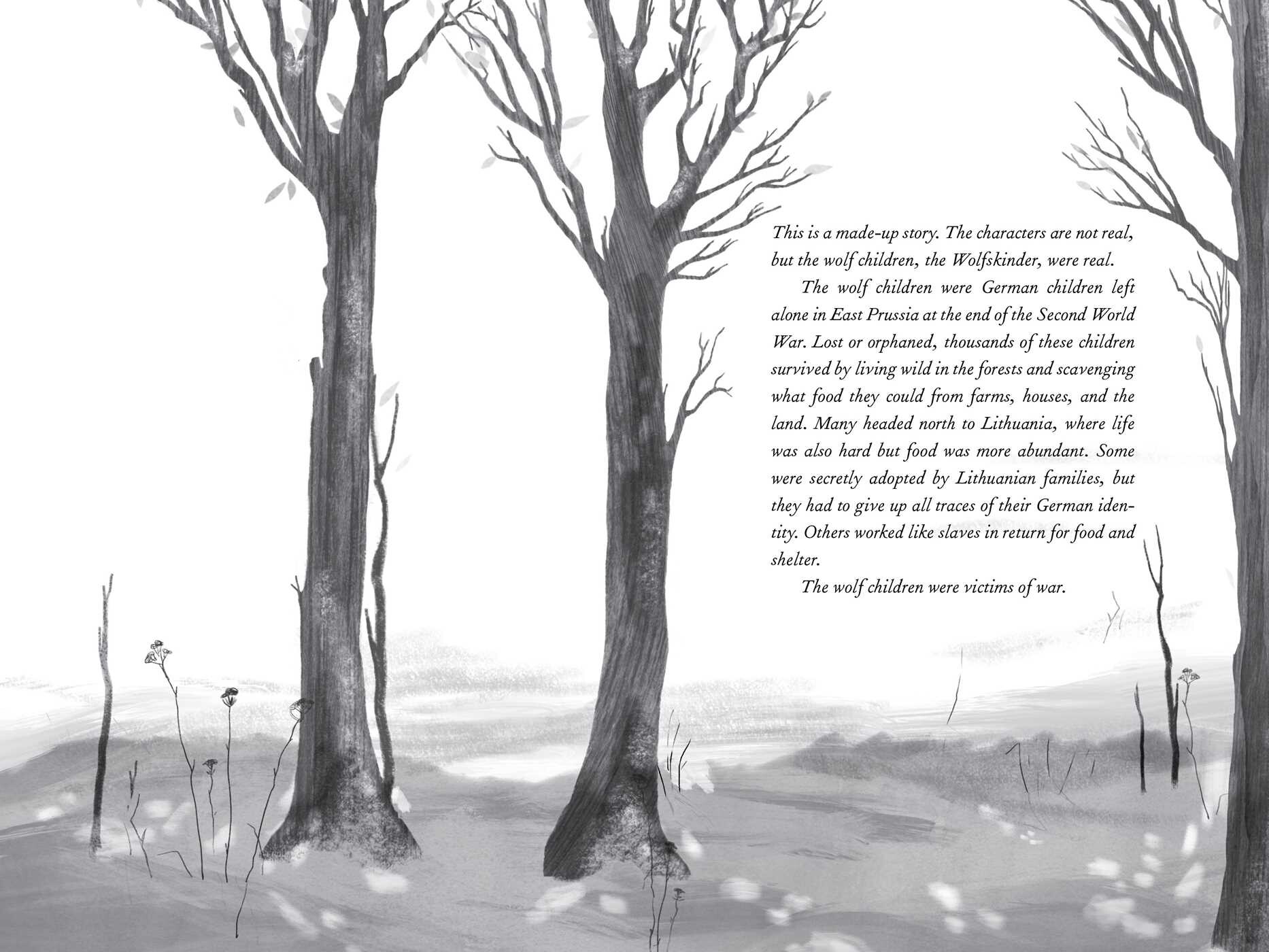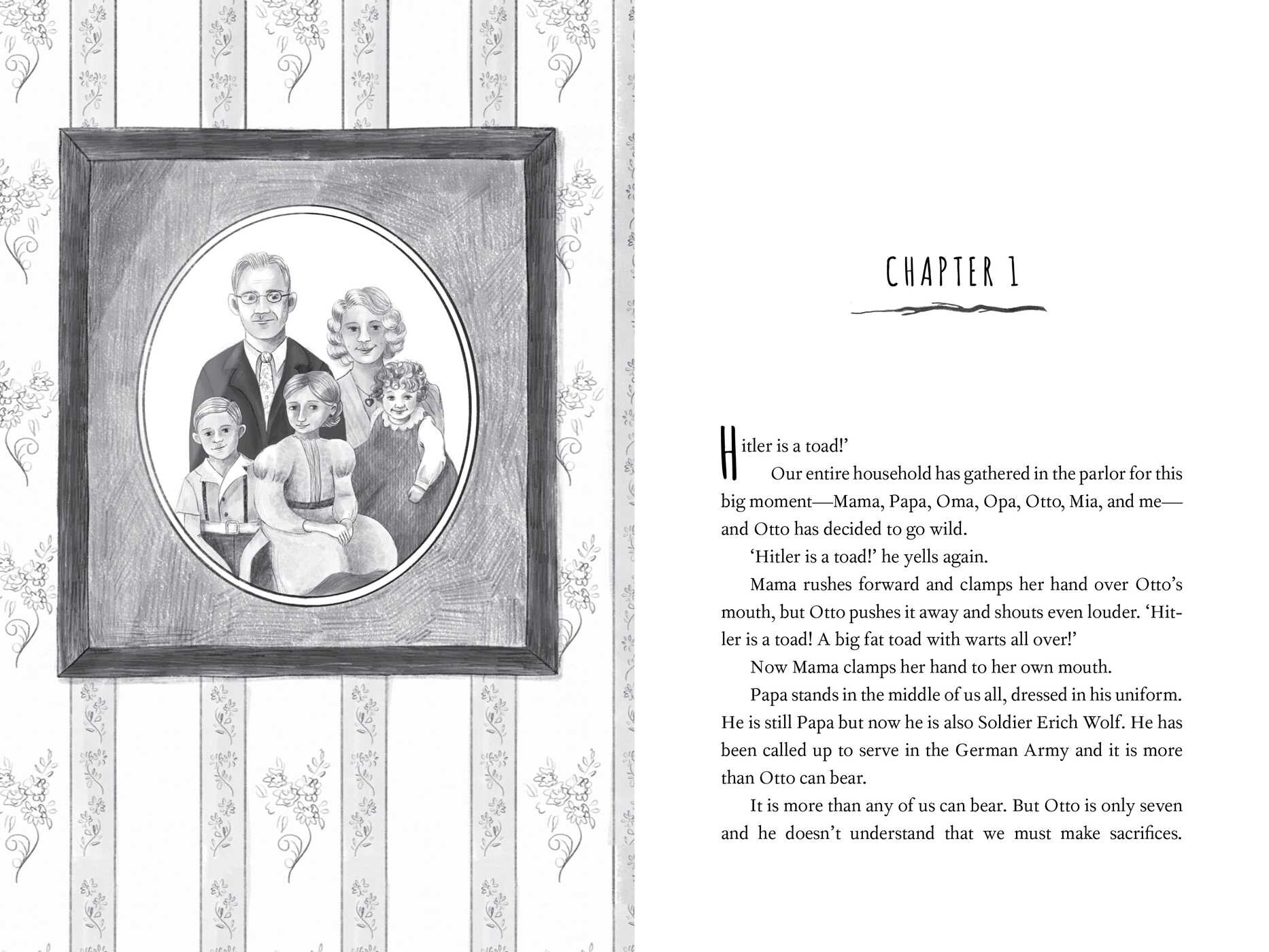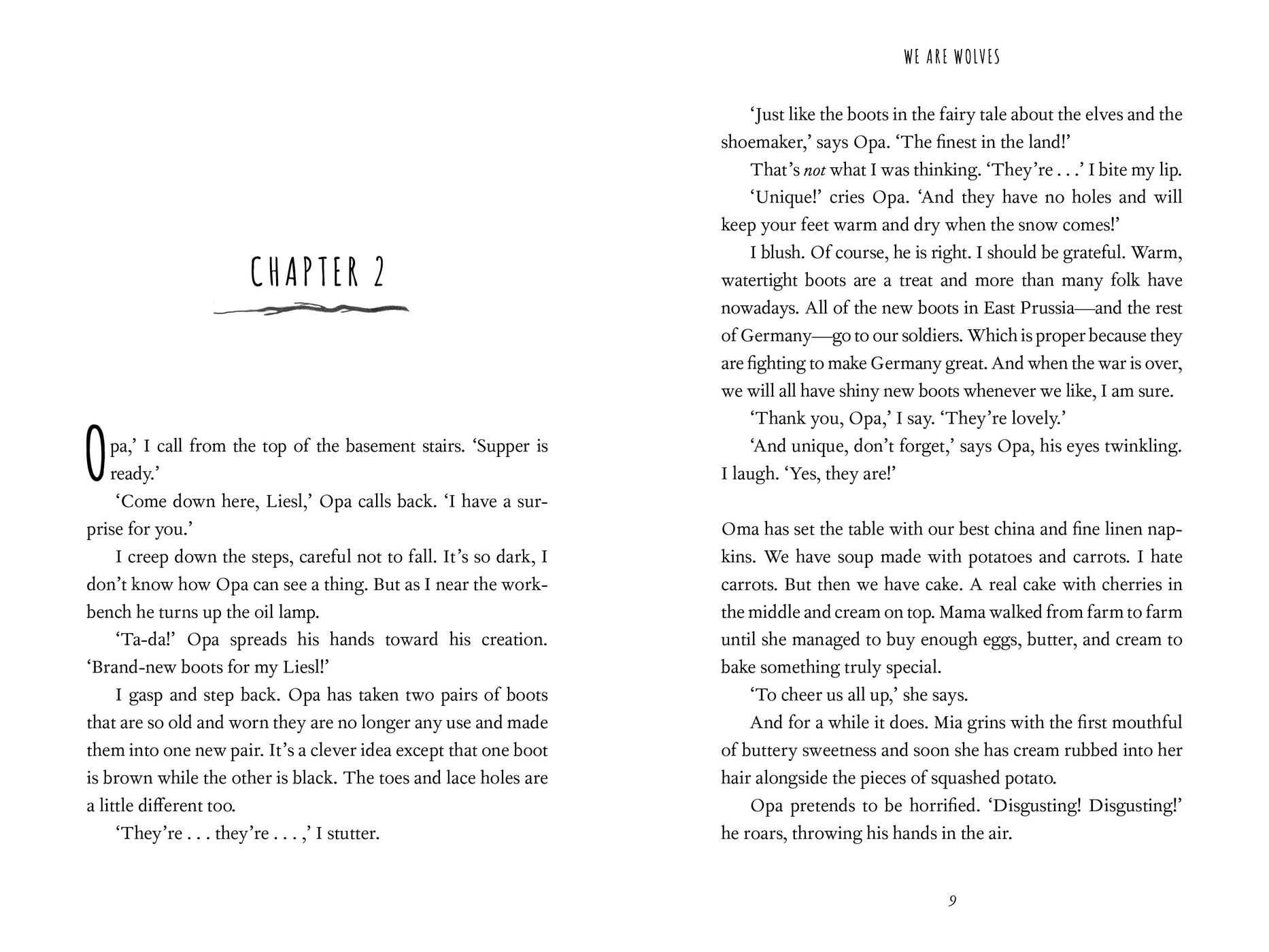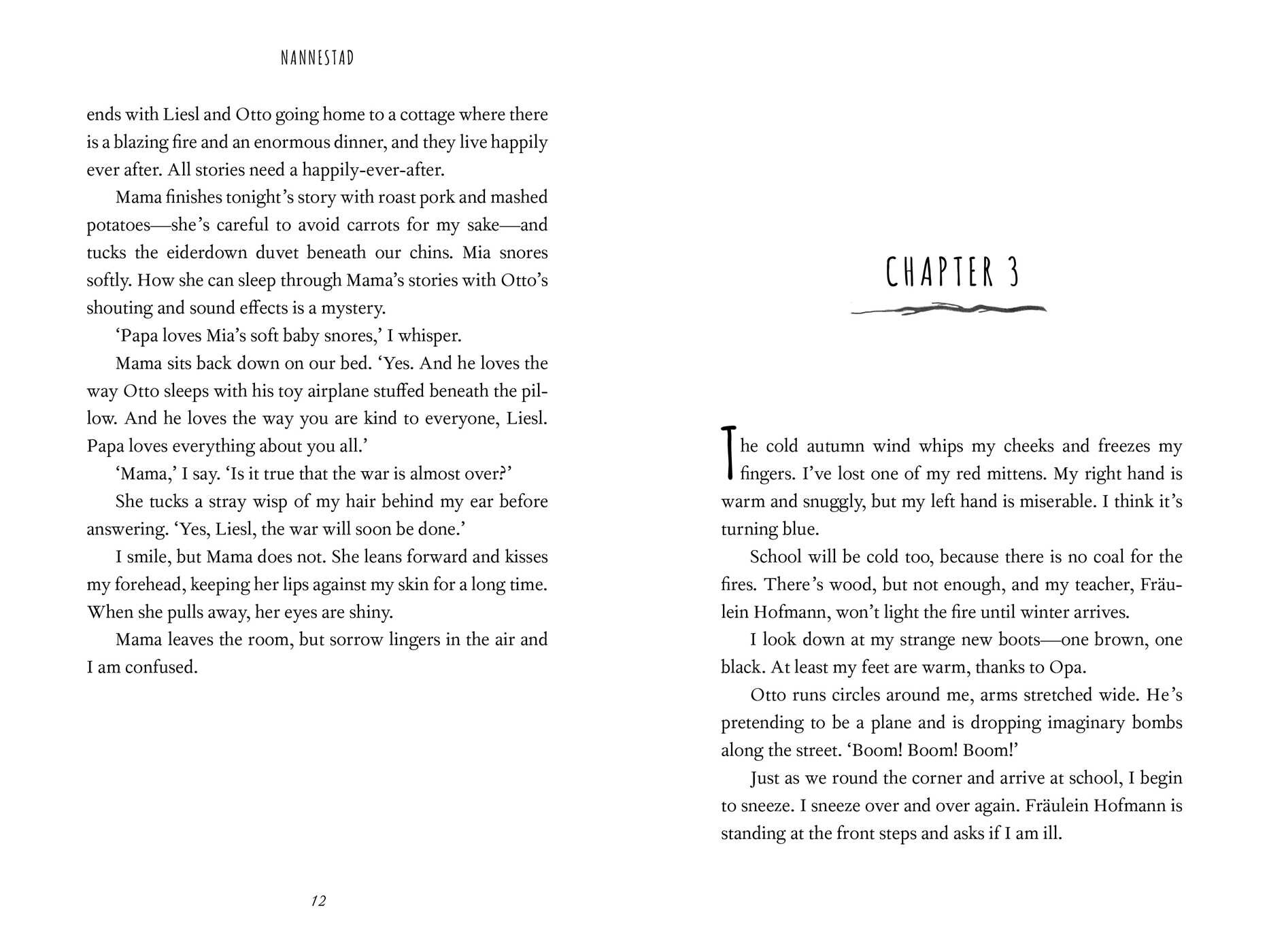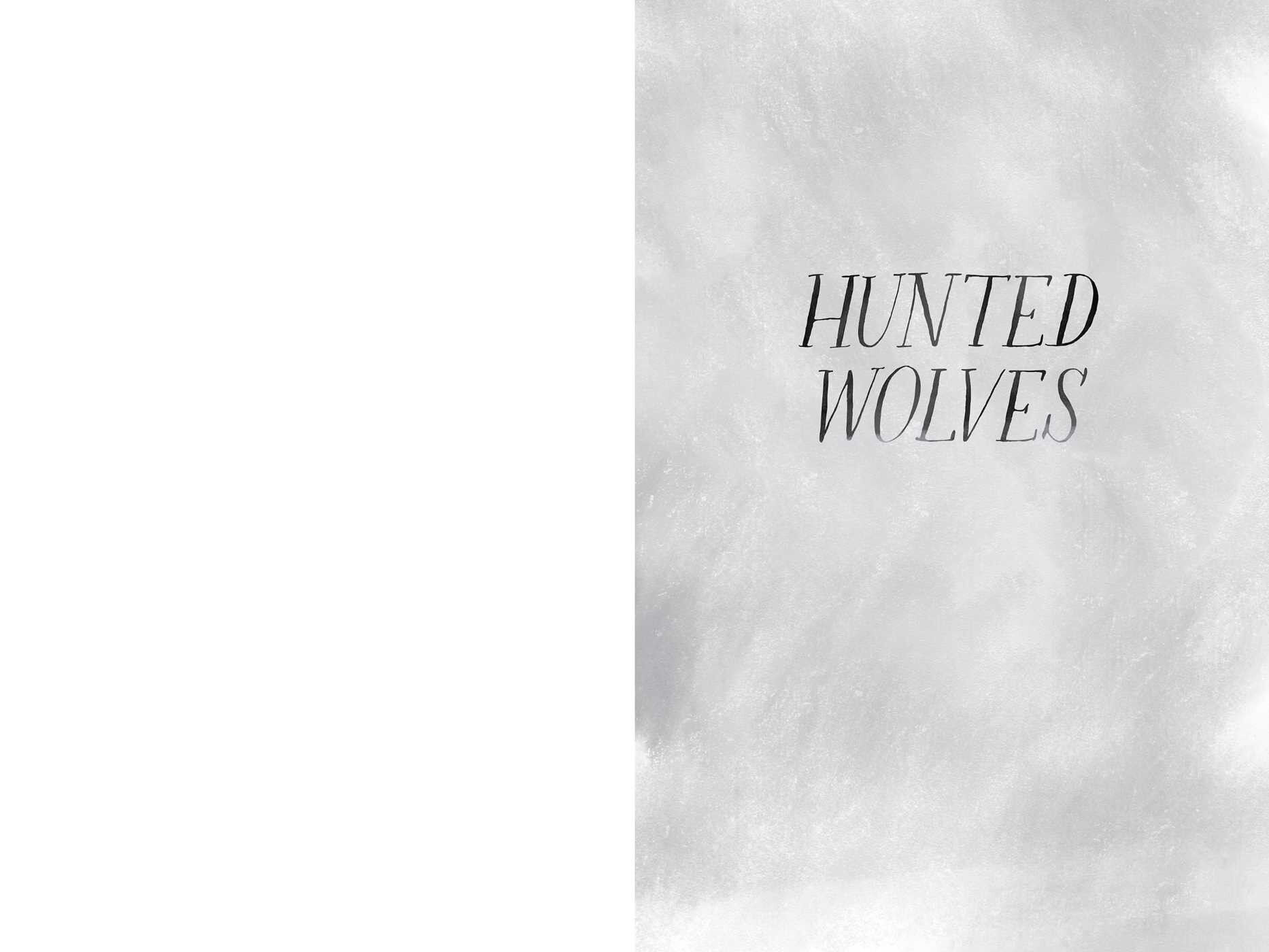Get our latest staff recommendations, award news and digital catalog links right to your inbox.
We Are Wolves
Table of Contents
About The Book
Sometimes it’s good to be wild. Sometimes, you have to be.
When the Russian Army marches into East Prussia at the end of World War II, the Wolf family must flee. Being caught by the Russians or the Americans would be the end for them. Liesl, Otto, and baby Mia’s father has already been captured, and they get separated from their mother in a blizzard after only a few days on the run.
Liesl had promised Mama that she’d keep her brother and sister safe, no matter what. They’ll forage in the forests if they have to. Little do they know that there are hundreds of other parentless children doing the very same thing. And they far too quickly learn that, sometimes, to survive, you have to do bad things.
Dangerous things. Wild things. Sometimes you must become a wolf.
Excerpt
Reading Group Guide
Join our mailing list! Get our latest staff recommendations, award news and digital catalog links right to your inbox.
We Are Wolves
By Katrina Nannestad
About the Book
At the end of World War II, the Wolf family is forced to flee their home in East Prussia. In their attempts to outrun the Red Army, three siblings, Liesl, Otto, and baby Mia, become separated from their mother and are forced to fend for themselves in the forest. Liesl, the eldest, promised her mama that she would keep her siblings safe. She will do whatever it takes to stay together until they are reunited with their mother. They come to realize that they are not the only German children that have become Wolfskinder, living wild in the forest. In order to survive, sometimes they must do dangerous things. Bad things. They must become wolves.
Discussion Questions
1. In the first section of the book, “Proud Wolves,” many adults in the Wolf children’s lives attempt to keep information about the war from the children. It becomes evident that Opa, Mama, and Fräulein Hofmann, among others, know more about the status of the war than they let on. Why do they choose to shield the children from certain information? How does this impact the Wolf siblings throughout the rest of the story? When Liesl and Mama go out to shop for Christmas, a soldier says to Mama, “‘It is bad. Far worse than they are telling you.’” (Chapter 4) Discuss how the Wolf adults keeping information about the war from the children is similar to the Nazi government’s control over what information is released to the German public.
2. During conversations about Germany’s leader at the time, Adolf Hitler, Liesl notices Opa’s adverse reactions, which she attributes to a possible cold. Why is Liesl so quick to explain away Opa’s snorts and scoffs? What does moving Hitler’s portrait to face the wall symbolize? Throughout the story, Liesl refers to “our beloved leader, Adolf Hitler,” while Otto repeats the phrase “Hitler is a toad,” as well as other insults. How do Liesl’s and Otto’s distinctly opposing views about Adolf Hitler also reflect their approaches to following rules and how they each absorb information?
3. Nationalism is defined as loyalty to and belief in one’s own nation, often resulting in the belief that one’s nation is better and more important than other nations. Find examples of nationalist ideologies in the text. How did ideas of German superiority contribute to the horrors of the time period? Discuss the scene in chapter three in which the soldiers march off to war. How does this scene represent German nationalism of the time? Compare this scene to the one at the end of chapter four, in which the soldiers are “not marching. They are straggling. Some are carried on stretchers.” What change has occurred between the two scenes? What might it symbolize?
4. Throughout the story, various objects, animals, and characters represent more than what they truly are, such as the lost red mitten, cows, Charlotte’s party dresses, and more. Find additional examples and discuss what they symbolize.
5. Storytelling and fairy tales become an important part of the Wolf children’s journey. Otto’s favorite bedtime stories at the beginning of the book center around what he knows from growing up during this time―war. How do the stories they share change over the course of the book? Sometimes these fairy tales turn into nightmares of wicked witches and evil creatures. How do fairy tales and stories allow the Wolf children to process the events they have experienced? How does Liesl give Otto hope through the stories she tells him? What power do the stories afford the Wolf children?
6. Liesl and Otto confront new characters of different nationalities throughout the book, who cause them to reconsider what they previously thought they knew. Liesl quickly comes to trust Dmitri and realizes that “this Russian soldier who is my enemy is a kind man.” (Chapter 20) Why does Liesl believe that certain people are her enemies? Discuss how Liesl’s feelings of responsibility to her country impact her perspective when meeting new people. How do these new characters challenge Liesl’s preconceived notions? What greater lessons can be drawn from Liesl’s realizations throughout the story about stereotyping and generalizing groups of people?
7. Liesl often reminds her siblings, “We are not wild. We are not wolves.” She also requires that she and her brother, Otto, recite the Wolf family tree to remember the names of family members. Discuss the significance of the distinction Liesl makes between wolves and their last name, Wolf. What do wolves symbolize in the story? Are there moments in the story in which the children are closer to “wolves” than “Wolfs,” and vice versa?
8. Despite Charlotte’s selfishness and nasty behavior toward all the children, Liesl is kind toward her. Why does Liesl help Charlotte even though “it doesn’t take long to realize that she is horrible”? (Chapter 33) What does this reveal about Liesl’s character? How does Liesl’s kindness ultimately benefit her?
9. As Liesl, Otto, and Mia attempt to fend for themselves in the wilderness, their loss of innocence is demonstrated in many ways, including working for the Russian army, their willingness to kill animals for food, and the way their priorities shift as they attempt to survive. When Liesl sees her reflection in a mirror for the first time in a long time, she has trouble recognizing herself:
She’s thin, with greasy, lank hair, and she’s dressed like a boy. But the strangest thing about her is her eyes. They are too big, too watchful, too hard. They look like they’ve been stolen from an adult’s face. . . . It’s me, but it is not me. (Chapter 26)
What changes has Liesl experienced while looking after her siblings? Find examples from the text of times Liesl and Otto felt obligated to be more adultlike. How does each child hold on to aspects of their childhood and life from before they left their home in East Prussia? How do they still find ways to act like children?
10. After experiencing so much hardship, small acts of kindness feel monumental to Liesl. With each kind act, Liesl is overcome with appreciation and comes to realize, “We are all the same deep down. German. Russian. Children. Soldiers.” (Chapter 25) How do small acts of kindness allow Liesl to rethink her previous notions about identity, nationality, and morality? What other acts of kindness impact the Wolf children? How do they attempt to thank those who are kind to them?
11. In chapter 32, Liesl, Otto, Karl, Bruno, and Josef take turns crafting a bedtime story with each child adding on a bit at a time. With each addition from another child, how does the bedtime story reveal the children’s wishes, hopes, and needs?
12. The concept of family runs throughout the story in the Wolfs’ typical, biological family, as well as in the “family” units that are formed for reasons such as safety and survival. Identify the various types of families the Wolf children build throughout their journeys. How does their concept of family expand throughout the story? Describe a person in your life who you consider family, but who is not part of your nuclear family unit.
13. As the Wolf children fight for survival, they work hard to hold on to their identities. Discuss how their identity as German children and their Wolf lineage are intertwined. Liesl recites her family tree and asks Otto to do the same to make sure they do not forget who they are. When the children reach Lithuania and begin living with Magdalena and Dovydas, they are told to change their names to keep everyone safe from discovery. Discuss Liesl’s and Otto’s differing reactions to adopting new identities. Why is Liesl convinced that ““We must never forget. We are Wolfs and we will always be Wolfs’” (chapter 40), whereas Otto doesn’t mind changing his name and becoming someone new? What does a name signify to each one?
14. As Liesl gains new experiences and begins to adopt a new perspective based on the challenges she has faced, she sees certain moments or items as “treasures” that she might not have found special before, like Mia using the toilet for the first time. Identify more of these moments in the text, and discuss what makes them so significant to Liesl.
15. The image of ducklings following a mother duck comes up frequently throughout the story in the form of nursery rhymes, stories, and more. Find moments in the story where this imagery can be seen, and discuss its significance.
16. The Wolf children have a firm understanding of right and wrong at the beginning of the book. At times, they feel immense guilt for their actions: “Thieves, I think. We have become dirty thieves and vandals.” (Chapter 15) Discuss how this understanding evolves throughout the story. At what point do they begin to bend the rules, and why? How do they justify their stealing, hunting, and rule breaking? How does this impact their self-worth and how they see themselves and others? Do you think that there are times in which it is acceptable to break rules? Explain your reasoning.
17. Throughout the story, Liesl encounters moments of profound beauty. Discuss examples of these moments and how beauty not only gives Liesl hope, but aids in her survival.
Extension Activities:
1. Travel Through Time Lines. We Are Wolves is set at the end of World War II during the evacuation of East Prussia. Research some of the major events of World War II and the immediate post–World War II era, such as the German invasion of Poland, the Battle of Britain, the Battle of Stalingrad, D-Day, the Battle of Midway, the liberation of Buchenwald, and the Potsdam Conference, among others. Create a digital or poster board time line with headings, images, and descriptions depicting these pivotal events throughout World War II. Present these time lines to the class and discuss the significance of each event in history.
2. Pack a Bag. Throughout World War II, many groups of people were forced to leave their homes, not knowing if they would ever return. The Wolf children lived in East Prussia for their entire lives, until they were suddenly forced to flee. Mama struggles to pack only essential items for their journey, and once separated, the children end up with far fewer possessions than they originally planned. Liesl’s most prized possessions are the family photographs Mama gave to her. If you were forced to flee your home at a moment’s notice, what would be the five objects you would pack? Create a collage using images of items that are sentimental or essential to you. Write an artist’s statement describing the objects and what they represent to you.
3. Chain of Kindness. The theme of kindness runs throughout the novel as the children encounter people who are willing to help them, even if it means risking their own safety. This is very similar to the Righteous Among the Nations, people who took risks to save Jewish people who were persecuted during World War II. Using the Yad Vashem World Holocaust Remembrance Center database, research someone afforded the honor of Righteous Among the Nations. Share their story by creating a Google Slides or PowerPoint presentation to share with the class.
https://www.yadvashem.org/righteous.html
4. From Friends to Family. Throughout the story, the Wolf children absorb others into their family unit. Think of someone who is not technically a member of your family, but who you consider to be like family. Write an essay describing the person’s most endearing qualities and what makes them so special to you. Alternatively, you may choose to write that person a letter, explaining why you consider them to be like a family member.
5. Happily Ever After? Fairy tales and stories are important to the siblings as they try to make sense of their experiences and retain hope for the future. Research story elements in fairy tales and read a few classics, such as Cinderella, Hansel and Gretel, and Goldilocks and the Three Bears. Craft a fairy tale based on a historical event or personal experience. Who are the main characters? What challenges do they face? How do they overcome their obstacles? Consider what lesson you would want a reader to take away from your story.
This guide was prepared and written by Colleen Carroll and Brianna Gitnik for Carroll Education Services. Colleen is a literacy specialist, curriculum developer, reading specialist, and author of the How Artists See series. Brianna is a fourth-grade general studies teacher, literacy coach, and teacher-leader. She holds a master’s degree in education with certifications in literacy and special education.
This guide has been provided by Simon & Schuster for classroom, library, and reading group use. It may be reproduced in its entirety or excerpted for these purposes. For more Simon & Schuster guides and classroom materials, please visit simonandschuster.net or simonandschuster.net/thebookpantry.
Product Details
- Publisher: Atheneum/Caitlyn Dlouhy Books (January 17, 2023)
- Length: 304 pages
- ISBN13: 9781665904230
- Grades: 5 - 9
- Ages: 10 - 14
- Lexile ® 710L The Lexile reading levels have been certified by the Lexile developer, MetaMetrics®
Browse Related Books
Raves and Reviews
The children, particularly Lisle, are resilient and strong—great characters for middle school-age children to read about and learn from. Any child who likes historical fiction, especially stories about World War II, will enjoy this book. I loved it!
Highly Recommended
– School Library Connection, 3/1/22
A compelling mix of historical fiction, survival, and adventure, this title shines light on a little-known episode from history. Recommended for all middle grade collections.
– School Library Journal, *STARRED REVIEW*, 3/1/22
As Liesl undergoes thoughtful questioning and maturation in her thinking about the war’s players, her realistic yet optimistic voice grounds the book in a spirit of integrity, generosity, and love—a sensibility that gently permeates the siblings’ bonds with one another and with others.
– Publishers Weekly, *STARRED REVIEW*, 5/2/2022
A lesser-known story beautifully and sensitively told.
– Kirkus Review *STARRED REVIEW*, 12/1/2021
Sobering and enlightening.
– Horn Book Magazine, 9/1/2022
Readers who enjoy survival stories will be engrossed by how the kids get by in the woods, while unexpected dangers and allies propel the action forward toward hope.
– Booklist, 2/1/2022
Awards and Honors
- CBC/NCSS Notable Social Studies Trade Book
- USBBY Outstanding International Book
- NCTE Notable Children's Books in the Language Arts
- Children's Sequoyah Book Award Master List (OK)
Resources and Downloads
High Resolution Images
- Book Cover Image (jpg): We Are Wolves Trade Paperback 9781665904230


